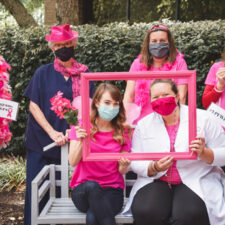Breast cancer is the most frequently diagnosed cancer in American women. Unfortunately, approximately one in every eight women (12 percent) will receive a diagnosis of breast cancer during their lifetime. This means virtually everybody knows a family member or friend who is personally affected by breast cancer. It is not at all uncommon to know several women (and occasionally men) who are somewhere on their journey from diagnosis to treatment to (hopefully) recovery.
Here are 7 things to know about breast health so you can start fighting breast cancer today.
1) Most women diagnosed with breast cancer have no known risk factors.
There are a number of risk factors that may predispose women to developing breast cancer, including age, obesity, gene mutations, dense breast tissue, late or no childbearing, alcohol and tobacco use. However, it is extremely important to note that most women diagnosed with breast cancer have no known risk factors. In particular, a negative family history does not mean that a woman is not “at risk” for developing cancer.Therefore, it is crucial that all women consider their breast health and breast cancer screening to be essential components of their overall health assessment.
2) The breast cancer survival rate is improving.
The breast cancer survival rate has steadily increased due to improved screening practices (early detection!), risk-reducing medications and surgery, and improved treatments for those already diagnosed. In large part, regular screening practices result in breast cancer detection at earlier stages when the cancer is easier to treat.
3) There is no upper age limit for screening mammograms.
The American College of OB/GYN recommends that annual screening mammography begin at age 40 in women at average risk and continue until at least age 75. There is no upper age limit for screening; decisions to stop screening should be based on general health and anticipated longevity, not age alone. In fact, since age is the greatest risk for developing breast cancer, I would encourage all women to continue screening throughout their entire lifetime.
4) 3D mammography safely provides better imaging.
Tomosynthesis, or 3D mammography, has the best detection rate and has become the standard imaging modality. 3D mammograms are especially important for women who have dense breast tissue, which is about half of women.
The radiation exposure from mammography is very low, and the likelihood of mammography detecting breast cancer in an early, and therefore curable, stage is far greater than any risk from mammography itself.
5) Additional screening is necessary for those who are high-risk.
Some women are identified as being at high-risk based on family history, genetic mutations (i.e. BRCA 1 and 2, although there are others as well), breast density, and biopsy proven breast pathology. Particularly when their lifetime risk is assessed as being 20% or greater, additional screening is generally recommended. This usually consists of annual 3-D mammography and annual breast MRI, recommended 6 months apart so screening occurs twice per year. For some high-risk patients, breast imaging may begin earlier than age 40.
Genetics counseling and testing is recommended to patients in whom there is a strong family history of breast and other cancers. Women who are found to carry gene mutations that place them at very high risk are offered the option of risk-reducing surgery (i.e. mastectomies).
6) Breast self-awareness is now recommended instead of monthly self breast exams.
All women are encouraged to develop a sense of breast self-awareness so that they are familiar with their own anatomy and the normal architecture of their breasts. If any changes are detected, women are encouraged to visit their healthcare provider for further evaluation. Breasts may feel different during different phases of the menstrual cycle; therefore detecting a change is not an immediate cause for alarm, but also should not be ignored. Your provider will be able to advise you about next steps.
7) Many women diagnosed with breast cancer have no symptoms.
The most common symptom of breast cancer is a mass or lump, which is what women might detect when practicing breast self-awareness. However, breast cancer can develop without any symptoms. This is just one more reason why routine screening mammograms are important.
Please encourage all of the women in your life to undergo regular screening – you just might save a life!
 VPFW offers screening mammograms at four locations. Call 804-897-2100 or go to vpfw.com make an appointment. Check out all their Breast Cancer Awareness Month activities, including how you can enter our Pink Purse Raffle.
VPFW offers screening mammograms at four locations. Call 804-897-2100 or go to vpfw.com make an appointment. Check out all their Breast Cancer Awareness Month activities, including how you can enter our Pink Purse Raffle.
To learn about VPFW’s campaign of enlightenment and care during breast cancer awareness month – including how to get a free mammogram if you’re not insured and how to win cool prizes when you use #MammogramsSaveLives – go HERE.
To read about about breast cancer and breast health at RFMonline.com, go HERE.







